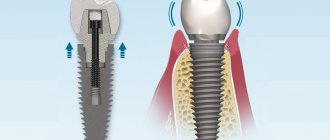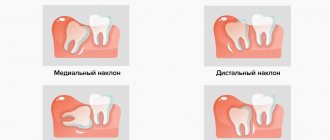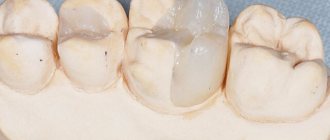If the resulting hole in the tooth is not filled in time, it may collapse and will have to be removed over time. You need to figure out why holes appear in teeth and how to deal with them.
The most basic reason for the appearance of a hole is tooth disease with caries, which first appears as a small dark spot on the tooth enamel. If caries is not treated at the initial stage of its appearance, it can gradually grow, penetrate into the tooth pulp and form a carious cavity. This cavity must be filled so as not to lose the entire tooth. A filling is placed if the tooth is affected by simple caries or complicated caries, or if pulpitis or pericementitis occurs.
How does a hole form in a tooth?
Let us make a reservation that a hole in a tooth is not a diagnosis, but a consequence of a dental disease. The phenomenon visually indicates that there is a problem.
Ideal teeth are straight and smooth. Uncleaned food debris leads to the formation of a special film on the teeth. Dentists call this film plaque. It contains a large number of bacteria. Over time, plaque hardens and becomes strongly attached to the teeth. Pathogenic organisms that are inside produce a specific acid that quickly destroys tooth enamel. It turns out that bacteria and microorganisms gradually begin to destroy teeth. As a result, a person gets a disease such as caries.
Stages of tooth destruction
Initially, small holes are obtained. Later they expand, turning into a hole. The described process can be divided into the following stages:
- First stage: initial. First, a whitish spot appears on the surface, which is the start of the destructive process. Over time, this spot turns from white to brown. At this stage, there are no other (let alone unpleasant) symptoms. Therefore, we people sometimes do not even know about the onset of the disease. At this time, only a dentist can detect it.
- Second stage: development of superficial caries. If the stain is not removed in time, painful microorganisms will affect the very top layer of tooth enamel. A more serious inflammatory process will begin, which is characterized by destruction. Here patients can talk about their complaints. Usually at this time the teeth are very sensitive. They react to temperature changes and acidic foods.
- Third stage: middle. Not only enamel, but also dentin suffers from destruction. Visually you can see a small hole. This is where food regularly falls and is left to rot. In addition to the sensations of the second stage, a reaction to chemical components is added. In addition, a person usually feels pain from inhaling air with an open mouth. If the tooth is not treated, the painful sensations will begin to torment constantly. Even painkillers cannot relieve the symptoms.
- Stage four: deep caries. The hole turns into a cavity and becomes quite large in size. The enamel and dentin itself are made very soft. If you touch the open bottom, you may feel pain. Inflammation of the nerve and vascular tissue begins. As a result, caries turns into pulpitis.
What happens if you leave the problem without a solution?
Tooth perforation is a fairly serious problem leading to various dental problems. If a cavity forms in the root canal, root apex or tooth walls, immediate treatment is required. Lack of therapy can lead to the following consequences:
- the development of a granuloma - a cavity filled with pus, which can grow, gradually affecting nearby tissues;
- if left untreated, granuloma can develop into a cyst;
- if the tooth structure is severely damaged, root fracture may occur, which is difficult to detect without x-rays;
- development of inflammatory processes with severe painful symptoms that complicate chewing food;
- Aggravated tissue inflammation can affect speech, causing speech defects.
The perforation options don't end there. Various inflammatory and destructive processes can develop, which lead not only to dental diseases, but also to their loss.
Reasons for the appearance of holes
A hole in a tooth is a consequence of the carious process. It is formed under the influence of several factors:
Features of people's lifestyle
- improper diets, as a result of which the body weakens and loses essential vitamins.
- poor hygiene or its complete absence.
- insufficient content of such an element as fluorine in the enamel.
External factors
- Having an incorrect bite.
- Bad heredity.
- Floor. It is women who suffer more from caries than men. The above is related to hormonal changes in the female body. And also, it is the weaker sex who eat the most sweets and starchy foods.
- Poor quality of drinking water.
- Particular susceptibility to diseases.
Physiological factor
- Distance between teeth.
- Features of the structure of the jaw.
- Poor quality enamel.
Geographical factor
Surprisingly, the occurrence of caries is influenced by the geographic location in which a person lives. It has been proven that climate, minerals, soil, and topography have a significant impact on human health in general, including teeth. Thus, almost all US residents (with the exception of only 1%) have serious dental problems. In Russia, only 40% of the population has healthy teeth, the remaining 60% suffer from dental problems. And in Norway, only 2% of the population complain of bad teeth.
Nutrition feature
Eating preservatives, carbohydrates, unnatural additives, and large amounts of sweets increases the likelihood of cavity formation many times over.
Types of temporary fillings
There are several options for temporary fillings:
- — Water-based artificial dentin. It is a mixture of distilled water and powder (zinc sulfate, zinc oxide, kaolin). The doctor brings the filling material to the desired consistency by adding water.
- — Oil-based dentin. The composition of such artificial dentin is the same, but not with water, but with clove or peach oil. The material does not need to be mixed; it is sold ready-made.
- — Special cement. There are several material options. It is used for teeth exposed to chewing stress. The product also serves as a gasket when filling canals.
- Polymers. The rubber-like paste, which hardens when exposed to light, is a durable material that adheres well to the surface of the tooth.
Hole in a tooth in children
It cannot be assumed that baby teeth are not susceptible to caries. This is wrong. Pathogenic and dangerous microorganisms very often affect baby teeth. During the period of replacement of temporary teeth with permanent ones, microbes that have settled on milk teeth calmly transfer to new ones that have just emerged. As you know, the entire process of changing teeth is quite long. Therefore, already in childhood, caries can be detected in a child’s mouth.
It is necessary to explain to the baby that he must take care of his oral cavity in the same way as his parents. Leftover food gets stuck between his teeth and causes the appearance of microorganisms. This should be avoided. Therefore, it is imperative to teach your child not only to use a brush, but also dental floss.
Dental filling methods
All methods of filling teeth are based on the use of various materials, which have their own advantages and disadvantages. Therefore, when choosing a technology, the doctor focuses on the individual characteristics of the structure of the root canals and the patient’s body as a whole.
Filling teeth with gutta-percha
Removal of the nerve of the tooth and filling of the canals, when the cavity is filled with a special paste based on gutta-percha with the addition of various impurities. Despite its simplicity and relatively low cost, this method of filling teeth cannot be called reliable and safe. It is often accompanied by a violation of tightness, the development of inflammation and allergic reactions.
Using a pin
Filling a pulpless tooth with pins is one of the most common techniques in dentistry. There are two types of pins (fillers): gutta-percha and metal. Filling tooth canals with gutta-percha is considered a more reliable and safe method. Even taking into account the presence of polymers, dyes and metal salts, such pins are biocompatible and do not cause allergies. Silver metal structures have good flexibility and can be installed in long and curved channels, however, silver is prone to oxidation, which can lead to inflammation. Titanium posts are better in terms of tissue compatibility, but they are very rigid and require the preparation of a special bed, which makes the tooth walls extremely fragile.
Sealers-sealers
Even gutta-percha pins for filling the root canals of teeth by themselves are not able to provide a reliable result, since they do not have antibacterial properties. To improve the quality of filling, dentists use sealers - sealants that ensure a tight fit of the material to the canal walls. There are natural (based on cement, zinc oxide, etc.), polymer sealers, glass ionomer cements and pastes based on calcium hydroxide.
Treatment of holes
Depending on the stage of the disease and the reason for the formation of the hole, a person may simply not be bothered by this cavity or may make itself felt by severe pain with fever. The hole must be healed with the help of a dentist. But if you still can’t get to the dentist’s office, you can relieve the pain at home.
Emergency help at home
If pain occurs, you should immediately brush your teeth. This will remove food debris from the mouth. Next, you should take any analgesic drug. The medicine will also help in case of fever.
If swelling is suddenly observed, it can be reduced by rinsing with soda. Or apply a piece of ice to the sore spot for 15-20 minutes.
Very often people resort to our grandmothers' recipes. The older generation claims that the following will help with initial pain in the tooth:
- A piece of lard, garlic, beets and bee propolis attached to the tooth.
- Normal tears, so you need to cry. Tears will relieve pressure in the jaw and thereby reduce the pain slightly.
- Massage the ear from the side of the diseased tooth.
- Gargling with herbal decoctions.
- Rubbing the sore spot with plantain juice.
Independent measures will only alleviate the condition, but will not cure the tooth. If a tooth stops seriously bothering you, this does not mean that the disease has gone away. The disease simply began to occur hidden. It went to the very depths and became chronic. In any case, you will have to go to the dentist.
Doctor's appointments
A hole in the teeth is treated according to the same scheme:
- First stage: thorough treatment of the oral cavity. Here the doctor removes plaque and tartar from the diseased tooth or from the entire oral cavity.
- Second stage: prick or injection of an analgesic. This kind of pain relief is necessary. Under its influence, the patient’s panic fear of treatment goes away, he does not feel pain and thereby allows the doctor to calmly do his job.
- Stage three: removal of infected tissue. Removal is carried out throughout the entire tooth cavity using special dental devices. Next, the doctor coats the walls of the exposed tooth with a bur or antiseptic. As a result of this action, the growth of bacteria and further relapse of the disease stops.
- Stage four: drilling out the cavity to install the filling. This is necessary so that the new installed material fits tightly into the tooth.
- Fifth stage: application of filling material or protective seal. They try to match the material as closely as possible to the color of the patient’s natural teeth. If suddenly the patient’s tooth has been affected by deep caries, then a therapeutic pad is placed at the bottom of the cavity. It will relieve inflammation from the nerve. Read about how to kill a nerve in a tooth here.
- Stage six: adjusting the filling to the shape of the tooth. This action helps the patient not to experience discomfort when chewing in the future.
What to do when your tooth already hurts?
Immediately contact a dentist who will treat the diseased tooth and, if necessary, install a filling on it.
To prevent the development of tooth pain, you must regularly undergo preventive dental examinations by a dentist, who can diagnose caries at an early stage of development and prescribe dental treatment. Untimely treatment can lead to tooth decay and loss.
A filling is the main protection for a hole in a tooth.
Filling material may vary. Let's look at the main ones.
Metal fillings
- From amalgam. It is a special metal combined with zinc, silver, tin and mercury. Currently, copper and silver amalgams are used. Such fillings are quite strong, plastic, they are notable for their low price and good fit to the edges of the cavity. The service life of amalgam fillings is 15 years. The material is able to accurately replicate the shade of the tooth. But a tooth with such a filling stands out from the entire dentition. Such fillings take too long to harden and are difficult to fit into the cavity. In addition, mercury vapor released during work is harmful to the health of the dentist.
- Made of gold alloy. They have enviable strength and a very long service life. But they are practically not used because of their visual visibility. In addition, a gold filling is an expensive pleasure.
Plastic fillings
They are used to temporarily protect the hole. They have good resistance to chemical components, harden quickly and do not irritate the patient’s oral cavity. However, such fillings quickly shrink and change their original shade over time. Plastic fillings can be made:
- Made from acrylic oxide. The material is resistant to any external influence, retains its original shade for a long time, fits tightly to the tooth and gives only slight shrinkage. The disadvantages of such fillings include their toxicity and the ability to start an inflammatory process under the installed filling.
- Made from carbondent. Compared to the filling described above, it has high density and low toxicity. However, such material quickly darkens and breaks.
Ceramic fillings
They are used quite often. They have the necessary advantages: the ability to maintain their size, do not shrink, and have increased hardness. At the same time, the shade of the filling does not change over time. The load under such a filling is distributed evenly over the entire tooth. In addition, ceramic fillings have excellent aesthetics, but high cost. This type of filling can be made of pressed ceramics or metal ceramics.
Composite
These fillings instantly harden under the influence of a photopolymerization lamp, or rather its light. They are distinguished by good strength and the required aesthetics. They are quite easy to polish. Such light fillings are practically indistinguishable from natural teeth. Therefore, reflective materials are often placed on the front teeth. As for shrinkage, they are not strong.
Cement
- Zinc phosphate. Used only to secure other fillings or as a spacer before a regular filling is installed.
- Glass ionomer. The material is quite durable and can last a long time. Such fillings are non-toxic and have excellent adhesive properties. During wear, the filling releases the necessary fluoride, which protects teeth from caries. However, the filling made from the cement in question is fragile and wears out very quickly. Therefore, it is usually used as gaskets and securing inlays in the hollow of a tooth.
- Silicate-phosphate. This is a very cheap filling material. It is often used in public dentistry. Such fillings do not stick to the surface of the tooth cavity. They do not conduct heat at all. However, these fillings are quite hard and transparent in appearance. Their disadvantage: they are toxic to the pulp.
- Silicate. This is long outdated material. It used to be placed after placing a zinc phosphate cement liner on the pulp tissue. Time has shown that this material has a negative effect on the pulp. Silicate cements are toxic and dissolve over time when exposed to saliva.
Weak and strong caries of anterior teeth
Spot
A chalky stain is a clear sign of a lack of minerals and the beginning of the destruction of the enamel structure. They are white in color and respond well to treatment at the initial stage. There may be a reaction to sweets.
Surface
At this stage, the enamel loses its integrity (which is especially noticeable upon probing), and the stain acquires a brownish tint. A painful reaction to temperature and chemical stimuli appears.
Average
The stage at which dentin is affected. A noticeable carious cavity appears on the surface of the tooth; over time, the crown part begins to change color. Severe pain occurs when eating cold and hot food and a reaction to sweets.
Deep
The most severe caries of the front teeth occurs when the deep layers of dentin are damaged. Severe pain from temperature stimuli and a pronounced aesthetic defect are observed.
Preventive measures
To prevent a hole from appearing in a tooth, you must:
- Adjust your diet. For these purposes, you need to exclude or greatly limit sweet foods, and include foods with fluoride, phosphorus and calcium in your daily consumption. Keep your consumption of carbonated drinks to a minimum.
- Visit the dentist. It is necessary to seek the help of a specialist even for minor problems in the oral cavity. Or go for preventive examinations twice a year.
- Maintain proper and regular oral hygiene. It is best to use fluoride toothpastes. Always rinse your mouth after each meal if you are not brushing your teeth.
- Clean your mouth at least 2 times a day.
- Choose the right brushes. Use medium to soft bristles. The nose of the tool should be rounded.
- Change toothbrushes every 4 months.
- If possible, buy an electric toothbrush and use it to clean. Studies have shown that it removes plaque very well.
- Clean properly. To do this, you need to hold the brush at an angle of 45° and make rotational movements with it in a circle, as well as back and forth. When brushing, do not put too much pressure on your teeth and gums. You should also try to clean the oral cavity from all sides.
- Be sure to clean your tongue. This is what often causes bad breath.
Is it possible to install a temporary filling yourself?
The installation of fillings should only be entrusted to a doctor. The fact is that, for all its rigidity, the tooth is very easily susceptible to infection. If you close a cavity in a tooth without proper preparation, there is a high probability of infection and the development of serious complications. The simplest thing is inflammation of the pulp, or pulpitis. In serious cases, the patient may lose a tooth and even harm neighboring ones if the inflammation spreads.
The desire to fill a tooth with temporary material may arise if a permanent or temporary filling falls out or a piece of the crown part of the tooth breaks off. In these cases, you need to make an appointment with a doctor as soon as possible, and while waiting for the visit, avoid getting food into the resulting cavity and follow simple rules.
Complications from the hole
It has been said that caries is the starting point for the formation of a hole. If it is not treated in time, pulpitis will begin, then the disease will develop into periodontitis. Pulpitis and periodontitis are often treated using surgical methods.
A feature of pulpitis is that the pulp chamber is opened. The person begins to suffer from severe pain. In this case, the occurrence of pain does not depend on irritating factors. The pain wears him down the most at night. Pulpitis can exist in two forms: acute and chronic. If this disease is not treated, it will develop into periodontitis.
With this disease, an abscess forms. If suppuration affects the underlying tissue, osteomyelitis will occur. If a lesion containing pus breaks through, blood poisoning may occur.
Prevention of caries
The easiest way to avoid fillings or minimize the number of fillings is to visit your dentist regularly. This should be done at least once every six months. Simple tips will also help keep your teeth healthy:
- Careful hygiene. You need to brush your teeth with a high-quality brush and toothpaste at least twice a day.
- Using dental floss will help remove plaque from hard-to-reach places.
- Rinsing with special liquids will also help keep your gums healthy, which play a huge role in keeping your mouth healthy.
- A balanced diet will help ensure you have enough vitamins and minerals to keep your teeth strong.
Now we treat teeth even better!
Treatment, re-treatment of canals, elimination of caries under a microscope without damaging healthy tooth tissue.
We do everything to save your own tooth. Consultation with specialists is FREE!
More details
What to do
Of course, you shouldn’t sit and wait for the pain and discomfort in the area of a tooth overgrown with gums to go away on its own. It is best to immediately contact a specialized dental clinic for medical advice. Only he will be able to conduct a comprehensive examination of the oral cavity, prescribe the necessary tests, conduct an X-ray examination and prescribe the correct treatment.
As a rule, a broken tooth that is overgrown with soft tissue is carefully removed. This requires making an incision in the gum. If the tooth is healthy, then after opening the hole the doctor can install an artificial root and prosthesis into it.
If it is not possible to save the tooth, then a procedure is performed to extract its root system. To do this, the specialist uses a special tool called an elevator, with which he cuts the top of the unit and gradually brings it to the surface. Such manipulations are carried out under local anesthesia and do not take much time. After extraction of a diseased tooth, a medicinal drug can be applied to the wound, which promotes faster healing. The stitches are removed after a few weeks.
Interdental caries: causes
As we said above, the reasons for the appearance of caries between teeth lie in an insufficient level of oral hygiene. Food debris stuck between the teeth (not only pieces of meat, but also just soft carbohydrate food residues that you do not feel) are processed by cariogenic microorganisms into organic acids, which dissolve tooth enamel. Thus, the main cause of caries in the interdental areas is the accumulation of food debris between the teeth, soft microbial plaque, and hard tartar.
But there are also predisposing factors. For example, if there is already a filling in this interdental space, and your dentist has not properly formed the contact point between the teeth, then this will contribute to the development of another interdental caries. The same applies to cases when dentists make a filling in the interdental space with a ledge (normally there should not be one), which injures the gingival papilla, causing its inflammation. This factor also contributes to the appearance of tartar and caries in the interdental space.











